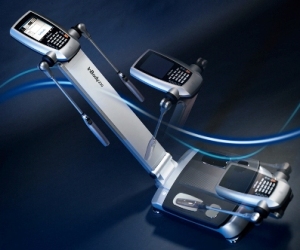Eventually, I'm sure, Melaine is going to post her progress and results we have been tracking all along the way through her journey. Nothing is more discouraging than working so hard, only to be disappointed because we don't feel like we are making any progress, but not having any good solid information or data to direct us one way or another. Well - my take on this is... if we don't track what we are doing as well as tracking what the results are, of what we are doing, then how can we ever know how to course correct?? So - how does Melaine track her progress? On one of these....
The InBody 230 is a body composition analyzer. This is what it looks
like! I'm going to try to answer several questions in this post
like...
1. How does it measure your composition?
2. How accurate is it?
3. Who can be assessed and who can't?
Answers:

1.
How does the InBody measure your composition? The InBody uses BIA (bioelectrical Impedance Analysis) to analyze your
body composition. If you are accustomed to using calipers to track your composition or any other tool - just remember that you can't compare this method with anything else. You'd be comparing apples to bananas - because BIA is a
technique that measures body impedance by sending an electrical current
through the body. NO - you do not feel the electrical current at all,
it is very low and very safe. The current only passes through the water
fluids inside the body, and based on the impedance values collected,
the body water volume is calculated. Since water fluids are usually
inside muscle tissues, by using the water volume, the fat-free mass can
be calculated. Body fat calipers measure skinfolds to calculate how
much subcutaneous fat(fat under the skin) a person has. So, a couple
of advantages here by using the InBody - it's highly accurate and not
subject to human error (me pinching in different places) AND you don't
have to put up with getting pinched which is a pain especially if I
haven't filed my nails - and plus, let's face it - it really puts us in a
vulnerable spot. Who likes to take their shirt off and let someone
pinch their fat? However - the volume of body water fluctuates (I know
this is common knowledge here) to sustain homeostasis in the body -
which in turn, will affect each measurement. So - with this in mind, we
need to be as consistent as possible by following some standard preset
guidelines under the same conditions.
2. How accurate is this?
The InBody uses 8-point tactile electrodes - that easily contact the
body at 2 points in each hand and foot. All other BIA devices use
4-point tactile electrodes. The 8 point method, divides the body into 5
regions (left and right arm, trunk, left and right leg) with minimal
error rate, enhancing measurement reproducibility. The common method
using 4 electrodes, divides the body into only 2 regions (the upper and
lower body) which gives over-generalized inaccurate results. The
8-point tactile electrode method measures the 5 segments of the body
directly, giving pinpoint measurement of each section. This method
minimizes the error and detects the body water content and the level of
muscle development in each segment.
In addition to this 8-point
tactile method, InBody also uses a multi-frequency analysis. Other BIA
devices use a single frequency and estimates the amount of intracellular
water from the extracellular impedance values. A single, low-frequency
current hardly travels through the intracellular water resulting in
inaccurate measurements. The proportion of intra and extracellular
water is consistent in a healthy body; however, in children, elderly
people and obese people their amounts may be imbalanced. Generally,
extracellular water is measured by low frequency currents and
intracellular water is measured by high frequency currents and it is
important to know both. InBody uses a multi-frequency analysis -
accurately assessing both intracellular and extracellular water.
Add
the 8-point tactile electrodes and the multi-frequency analysis
capabilities to the fact that it measures 5 separate segments separately
to measure the amount of body water and fat-free mass in each segment -
makes for highly accurate results because each measured part isn't
affecting the measurements of the other parts. So it's not an
estimation - but rather a direct measurement.
3. Who can use this
and who can't? It is safe and accurate for kids, elderly and anyone up
to 500 lbs. It is NOT good for anyone with implanted defibrillators or
pacemakers. Although the electrical current that is sent through the
body is extremely low, it is not recommended. They also discourage anyone that is pregnant to use impedance -
Anyone want to see Melaine's Inbody progress reports??
Shine on!
Carrie

Great information! But, I suppose, the most important question for most of us is how much does it cost? :-)
ReplyDeleteas a numbers nerd I love information like this! I do weight myself daily but I also have my body fat tested yearly.
ReplyDelete